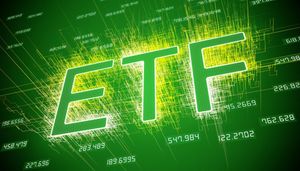
Micron Technology (MU:NASDAQ) has delivered a blockbuster fiscal fourth-quarter 2025 earnings report, showcasing record financial performance propelled by an insatiable demand for artificial intelligence (AI) related memory solutions. The results not only significantly exceeded analyst expectations but also provided an optimistic outlook for the coming quarters, underscoring the profound impact of AI on the semiconductor industry and setting a bullish tone for companies deeply embedded in the AI supply chain.
This exceptional performance, particularly in High Bandwidth Memory (HBM), confirms the accelerating AI boom and suggests a potential memory "super cycle" is firmly underway. While the initial market reaction to Micron's stellar report was somewhat muted, hinting at a possible "digestion phase" for AI-linked stocks, the underlying fundamentals signal robust long-term growth and a significant shift in market dynamics.
Micron's Record Quarter: Fueling the AI Revolution
Micron Technology's fiscal Q4 2025, ending August 29, 2025, was nothing short of extraordinary. The company reported a staggering revenue of $11.32 billion, marking a 46% year-over-year increase and a 21.6% sequential rise, comfortably surpassing analyst estimates. Non-GAAP diluted Earnings Per Share (EPS) reached an impressive $3.03, a dramatic turnaround from a loss in the prior year and well above forecasts. Gross margins improved significantly to 44.7%, reflecting strong operational efficiency and pricing power. For the full fiscal year 2025, Micron achieved record revenue of $37.38 billion, nearly 50% higher than fiscal 2024.
The driving force behind this unprecedented success is the explosive demand for HBM, essential for powering advanced AI models. Micron's HBM revenue alone hit nearly $2 billion in Q4 2025, indicating an annualized run rate of approximately $8 billion, largely due to the successful ramp-up of its HBM3E products. The company's CEO, Sanjay Mehrotra, emphasized that AI will catalyze trillions of dollars in infrastructure investment, with a substantial portion dedicated to memory solutions. Furthermore, Micron anticipates selling out all of its HBM production through 2026, with pricing agreements already in place for most of its HBM3E supply for calendar year 2026, highlighting the tight supply and strong pricing environment.
Analyst reactions have been overwhelmingly positive, with several firms, including Wolfe Research, Stifel, Mizuho, Wells Fargo, and Wedbush, raising their price targets for Micron's stock, some as high as $220. This positive sentiment is rooted in the structural shift in revenue towards data center demand and robust hyperscale memory margins. Micron's optimistic guidance for Q1 fiscal year 2026, forecasting revenue between $12.2 billion and $12.8 billion and adjusted EPS in the range of $3.41 to $3.71, further cemented confidence in its continued growth trajectory.
Market Ripple Effects: Who Wins and Who Loses?
Micron's exceptional earnings report sends a clear signal across the AI and semiconductor landscape, confirming the sustained and accelerating demand for AI infrastructure. As a critical memory supplier to leading AI chipmakers such as Nvidia (NVDA:NASDAQ) and Advanced Micro Devices (AMD:NASDAQ), Micron's performance serves as a powerful positive indicator for the entire AI ecosystem. This performance reinforces the narrative of a memory "super cycle," where persistent AI-driven demand leads to elevated pricing and increased revenue for memory providers.
In this environment, several companies are poised to be significant winners. Fellow memory manufacturers like SK Hynix (000660:KRX) and Samsung Electronics (005930:KRX) are likely to see increased investor confidence as the HBM market expands and maintains strong pricing. GPU manufacturers, including Nvidia and AMD, whose AI accelerators heavily rely on HBM, stand to gain substantially from the robust demand for advanced memory solutions. Furthermore, foundry and equipment suppliers such as Taiwan Semiconductor Manufacturing Company (TSMC:NYSE) and equipment manufacturers like ASML Holding (ASML:NASDAQ) and Applied Materials (AMAT:NASDAQ) are set for increased business as semiconductor companies invest heavily in expanding manufacturing capacities to meet future AI demand. Micron itself plans higher capital expenditures in fiscal 2026 for 1γ DRAM and HBM-related investments.
Conversely, companies with limited exposure to the burgeoning AI sector or those primarily focused on traditional, slower-growth segments of the semiconductor market might face increasing pressure. These firms may need to accelerate innovation and strategic pivots to remain competitive or risk being left behind in this rapidly evolving, AI-dominated market. The initial muted stock reaction for Micron, despite the "blowout" results, suggests that some AI enthusiasm might already be "priced in," leading to a potential "digestion phase" for AI-linked semiconductors as investors consolidate gains or exercise caution regarding high valuations. However, the long-term AI thesis, driven by structural demand, remains robust.
Broader Implications: A New Era for Memory and AI
Micron's recent success underscores a pivotal shift in industry trends, with AI now firmly established as the dominant growth driver. This marks a significant departure from the historical reliance on traditional devices like PCs and smartphones, shifting the memory market's focus towards data centers that prioritize bandwidth and power efficiency. This structural change is expected to mitigate the historical cyclicality of the memory business, leading to more stable and predictable growth patterns for memory manufacturers.
The competitive landscape in advanced memory is also intensifying, with Micron strengthening its position. The company's achievements in HBM4, including delivering samples to customers and achieving industry-leading speeds, places it squarely in a three-way race with its major Korean rivals, SK Hynix and Samsung Electronics. As the only U.S.-based memory manufacturer, Micron is uniquely positioned to capitalize on the AI opportunity, potentially benefiting from strategic national interests in semiconductor supply chain resilience. Mass production of HBM4 is slated to begin in Q2 2026, with full-scale production in the second half of the year, and Micron anticipates its HBM market share to expand in 2026 compared to 2025.
Looking ahead, the market is likely to remain dynamic. While analyst price targets indicate significant upside potential for Micron's stock, the recent muted reaction suggests that investors might need to consolidate gains before the next major rally. Nevertheless, the fundamental drivers of accelerating AI demand, tight supply, and expanding margins paint a positive long-term picture for Micron and other key players in the AI supply chain. Micron's commitment to substantial capital investment further underscores its confidence in continued AI-driven growth and its readiness to meet future market demands.
What to Pay Attention to Next
As the AI revolution continues to unfold, investors and industry observers should closely monitor several key developments following Micron's impressive earnings. In the short term, attention will be on the execution of Micron's HBM4 production ramp-up, which is scheduled to begin in Q2 2026. Any updates on production yields, customer adoption, and pricing agreements for HBM4 will be critical indicators of the company's continued competitive strength and market share gains in the advanced memory segment. The performance of other memory manufacturers, such as SK Hynix and Samsung Electronics, in their respective HBM development and production will also be important to gauge the overall supply-demand dynamics and competitive intensity.
Longer term, the focus will shift to how AI infrastructure investments translate into broader economic growth and corporate profitability. The continued build-out of data centers and the increasing adoption of AI across various industries will sustain demand for high-performance memory. Watch for announcements from major cloud providers and AI developers regarding their future hardware needs and partnerships, as these will directly influence the order books of memory and chip manufacturers. Furthermore, any strategic pivots or adaptations by companies currently with limited AI exposure, either through acquisitions, R&D investments, or new product lines, will signal their intent to capitalize on this transformative trend.
Potential market opportunities may emerge in ancillary sectors that support the AI ecosystem, such as advanced packaging, cooling solutions for data centers, and specialized power management components. Challenges could arise from geopolitical tensions impacting semiconductor supply chains or a potential oversupply in less advanced memory segments if production ramps up too quickly without corresponding demand. Regulatory or policy implications, particularly regarding national semiconductor independence and subsidies for domestic manufacturing, could also shape the competitive landscape and investment decisions in the coming years.
Conclusion: Micron's AI Bet Pays Off
Micron Technology's latest earnings report is a definitive testament to the profound and accelerating impact of artificial intelligence on the global financial markets and the semiconductor industry. The company's record-breaking performance, driven by surging demand for High Bandwidth Memory, not only highlights its strategic positioning but also serves as a critical bellwether for the broader AI stock universe. The era of AI-driven memory demand is firmly here, shifting the industry's focus and promising a more stable, growth-oriented future for memory providers.
Moving forward, the market will closely assess how Micron and its competitors navigate the intense competition in advanced memory technologies, particularly HBM4. The ability to innovate, scale production efficiently, and secure favorable pricing agreements will be paramount. Investors should watch for continued strong guidance from Micron and its peers, further indications of HBM market share shifts, and the broader capital expenditure plans across the semiconductor ecosystem. The sustained growth in AI infrastructure investment will be a key determinant of market momentum.
Ultimately, Micron's success underscores a fundamental transformation in technology. The strategic importance of high-performance memory in powering the AI revolution cannot be overstated, and companies that are at the forefront of this innovation are poised for significant long-term gains. While short-term market fluctuations may occur as investors digest recent gains, the underlying structural demand for AI-enabling technologies suggests a robust and exciting future for the semiconductor industry and those invested in its evolution.
This content is intended for informational purposes only and is not financial advice


















